
REPTILES
Cold-blooded and Covered in Scales!

REPTILES
Cold-blooded and Covered in Scales!
The first reptiles appeared approximately 315 million years ago. They were ectothermic (cold-blooded) and shared some superficial similarities to the amphibians who ruled the land at that time, but reptiles use their lungs to breathe from birth, possess watertight scale or scute-covered skin, and lay hard-shelled eggs which allows them to spend their entire lives on land. Reptiles became so successful during the Mesozoic era (about 252 to 66 million years ago), it was dubbed the “Age of the Dinosaurs,” a time that has inspired many a young paleontologist! Reptiles are still plentiful today, with many types of crocodiles, lizards, and snakes serving as representatives.
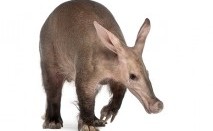 Aardvark
AardvarkAardvarks are nocturnal, burrowing mammals, recognizable by their characteristic pointy snouts and ears. The last known…
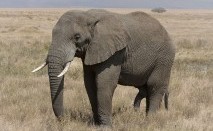 African bush elephant
African bush elephantThese charismatic giants are the largest living terrestrial animals, with an average height between 9.2 and 10.8 feet…
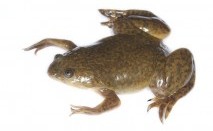 African Clawed Frog
African Clawed FrogThis species of frog is completely aquatic and has no tongue or teeth. They shove food into their mouth and down their…
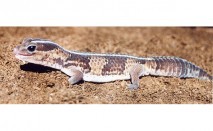 African Fat-tailed Gecko
African Fat-tailed GeckoThis nocturnal, ground-dwelling gecko is named for its adaptation of storing fat in its tail - these energy reserves allow…
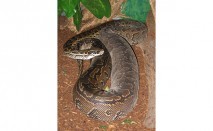 African Rock Python
African Rock PythonThis species is the largest native snake in Africa and one of the five largest species of snakes on the planet. They are…
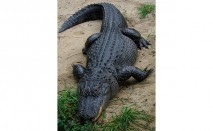 American Alligator
American AlligatorThis large reptile can reach lengths of 15 feet and a weight of almost 1000 pounds! They inhabit freshwater wetlands throughout…
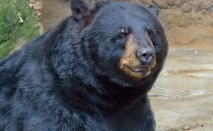 American black bear
American black bearThis medium sized bear is the most common and widespread of all bear species. They generally prefer to live in the forest…
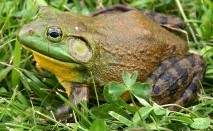 American Bullfrog
American BullfrogThese territorial frogs are named for their loud, deep call that reminds some of the roar a bull. They are often found…
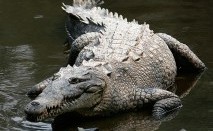 American Crocodile
American CrocodileThe range of this sizeable crocodile spans from both coasts of southern Mexico, to as far south as Peru and Venezuala,…
The American toad is a commonly occurring species throughout the Eastern United States and Canada and they can live almost…
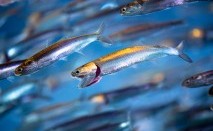 Anchovy
AnchovyAnchovies are small, oily fish that are found in scattered areas throughout the world’s oceans. They tend to be tolerant…
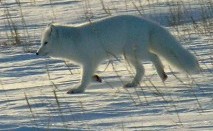 Arctic fox
Arctic foxThis small species of fox is native to the Arctic region of the Northern Hemisphere. Its dense coat, which is white in…
This is an omnivorous, terrestrial lizard that is native to the tropical rainforests, savannas and semi-deserts of east…
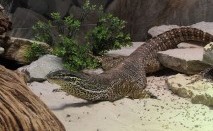 Argus monitor
Argus monitorThis monitor is found in northern regions of Australia and southern regions of New Guinea. They are versatile predators…
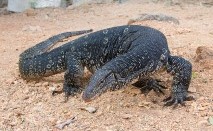 Asian Water Monitor
Asian Water MonitorThe Asian water monitor is the third longest lizard in the world, able to reach lengths of 9 feet, though 3-5 feet is…
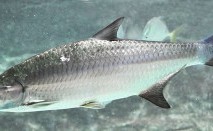 Atlantic tarpon
Atlantic tarponThese large, striking fish are typically found in tropical and sub-tropical coastal waters, estuaries, lagoons, and rivers…
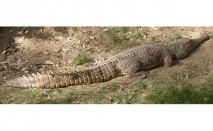 Australian Freshwater Crocodile
Australian Freshwater CrocodileThese crocodiles are found in northern Australia, in the states of Western Australia, Queensland, and the Northern Territory.…
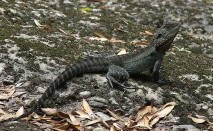 Australian Water Dragon
Australian Water DragonAustralian water dragons are arboreal agamids with strong limbs and long claws for climbing. They are very strong swimmers…
 Axolotl
AxolotlThese completely aquatic salamanders are also known as the Mexican salamander or Mexican walking fish. They are a neotenic…
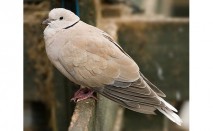 Barbary Dove
Barbary DoveThis species of dove is the most commonly kept dove in captivity, owing to their ease of care, hardiness, and pleasant…
This species of frog is native to the Southeastern United States. They are variable in color but recognizable by the dark,…
The basking shark is the second largest living fish after the whale shark and can be found in all the world’s temperate…
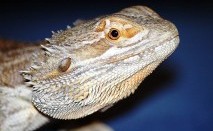 Bearded Dragon
Bearded DragonThere are eight species of bearded dragons in the Pogona genus, all adept climbers who are commonly found resting on branches…
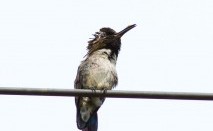 Bee hummingbirds
Bee hummingbirdsBee hummingbirds (Mellisuga helenae), native to Cuba, weigh about as much as a dime and are about 2.5” long, eat their…
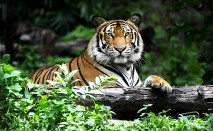 Bengal Tiger
Bengal TigerWhile it is the most common subspecies of tiger, the Bengal Tiger is still endangered, ranging only in India, Nepal, Bangledesh,…
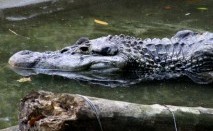 Black Caiman
Black CaimanThe black caiman is one of the biggest member of the alligator family – they are the largest predator in the Amazon…
These natives of the Paraguay Basin of Brazil are recognizable by the two distinct, longitudinal, adjacent stripes (one…
 Black-headed spider monkey
Black-headed spider monkeyThe black-headed spider monkey is an arboreal, diurnal species of primate native to Central and South America (New World…
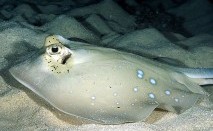 Blue-spotted stingray
Blue-spotted stingrayThe blue-spotted stingray is generally found in Indonesia to Japan, and south to Northern Australia. They are popular…
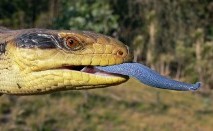 Blue-Tongued Skink
Blue-Tongued SkinkThese hefty Australian natives are named for their large blue tongues that are used as a bluff to scare off attackers.…
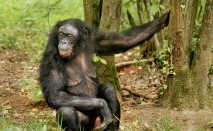 Bonobo Chimpanzee
Bonobo ChimpanzeeThese endangered great apes are one of two species making up the genus Pan, the other being the common chimpanzee (Pan…
The Brazilian, or South American, tapir is one of five species in the tapir family. They are large mammals– adults can…
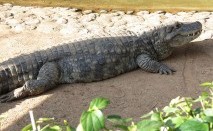 Broad-snouted Caiman
Broad-snouted CaimanThis broad-snouted caiman is found in Eastern and Central South America and prefers still or slow-moving waters such as…
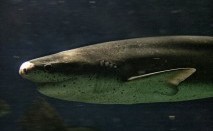 Broadnose sevengill shark
Broadnose sevengill sharkNotable for its seven gill slits (most sharks have five or rarely, six), the broadnose sevengill shark is also the only…
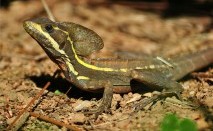 Brown Basilisk
Brown BasiliskBasilisks are native to Mexico, Central America, and northwestern Columbia. They have been nicknamed “Jesus Christ lizards”…
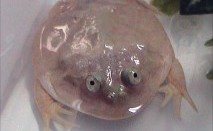 Budgett’s Frog
Budgett’s FrogThese frogs, sometimes called hippo frogs, are natives of Paraguay, Argentina, Brazil, and Bolivia. Budgett’s…
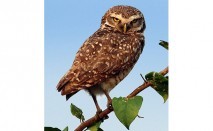 Burrowing Owl
Burrowing OwlAs their name implies, these owls live in burrows and are willing to either dig their own or inhabit those made by prairie…
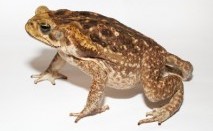 Cane Toad
Cane ToadThe Cane Toad is a very large, terrestrial toad native to the extreme southern United States and Central and South America.…
 Cane Toad
Cane ToadThe Cane Toad is a very large, terrestrial toad native to the extreme southern United States and Central and South America.…
Capybaras are the largest rodent in the world and can weigh in excess of 100 pounds! They are native to South America…
Cardinal tetras are native to the Orinoco and Negro Rivers of South America. These colorful fish, with their blaze of…
 Cattle
CattleThese large ungulates have been domesticated for more than 10,000 years. All the 1.3 billion cattle in the world are thought…
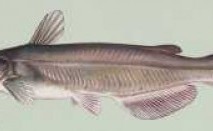 Channel catfish
Channel catfishThis species is North America’s most numerous catfish species, widespread throughout lower Canada, eastern and northern…
 Chinchilla
ChinchillaThe long-tailed or Chilean chinchilla are popular as pets and in the fur trade, but their wild counterparts are critically…
This species is significantly smaller than its only close cousin, the American alligator. It is further distinguished…
These small newts are black with bright-orange coloration on their ventral sides which they use to ward off predators…
“Clam” is an informal name that refers to bivalves (such as oysters, scallops, mussels, cockles, clams, and numerous…
 Coastal Plains Toad
Coastal Plains ToadThe range of this widespread toad extends from the state of Veracruz in Mexico, along the coast of the Gulf of Mexico,…
 Comb jelly
Comb jellyThis phylum of animals inhabits marine waters worldwide. They are named for their distinctive rows of cilia, or combs,…
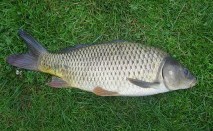 Common carp
Common carpThe common carp is native to Asia. Even though wild, native populations are considered vulnerable to extinction, it has…
For years, the Komodo dragon was accused of having a mouth so filthy that even if you escaped its terrible bite, you were doomed to eventually die from the ensuing bacterial infection. However, recent studies on Komodo dragons demonstrated that this was unfair, as they have mouths cleaner than many mammalian carnivores. It turns out the reality is worse than the myth: they have poison glands! Komodo dragons produce a venom that sends prey into shock while keeping its blood from clotting. A deer or pig who “escapes” will run off and go into shock, and bleed out from its wounds within 3 hours, leaving an easy treat for the dragon.
 Discover Animals is a web-based educational resource offered by the NAIA
Discover Animals is a web-based educational resource offered by the NAIA